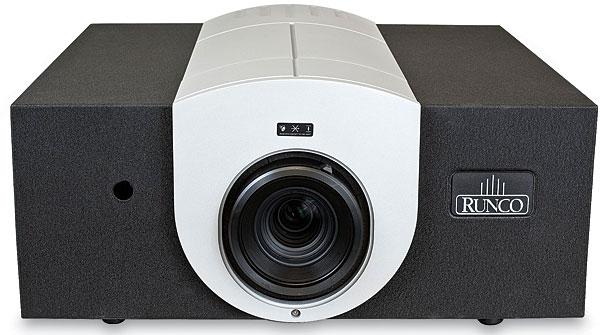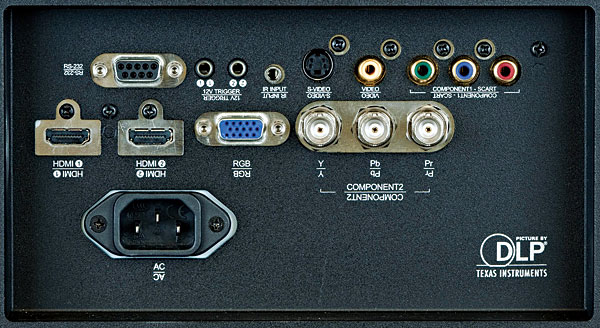Runco QuantumColor Q-650i LED-DLP Projector

Projection lamps: Can’t live without ’em, can’t shoot ’em. Until recently, that is.
Projection lamps are slow to turn on and off, hot, often unstable, and have a nasty habit of getting dimmer with age, while their color balance deteriorates. If you’re fussy about your video—and if you’re reading this review you should be—the 2,000-hour useful lifetime that’s usually specified (to half brightness) for projection lamps will likely be closer to 1,000 hours or less. With a replacement averaging around $400, that’s about $0.40 per hour of use, not including the bottom line on your electric bill.
LEDs, on the other hand, are more energy efficient and good for many more hours of high performance than a lamp. The Runco Q-650i employs the same PhlatLight LEDs from Luminus Devices as Runco’s $15,000 Q-750i, which we reviewed in September 2010. Runco calls its application of this technology InfiniLight, and claimed a useful LED lifetime of 60,000 hours for that projector, with a brightness decrease of perhaps as little as 10 percent, even at the end. Because the Q-650i uses the same technology, I would expect its LED longevity to be similar. While that may be a bit optimistic, it’s nevertheless likely you’ll be ready for a new projector long before the Q-650i’s LEDs show any significant deterioration.
But an LED projector powerful enough to fill a home theater screen is going to cost you. Until now, that has been $15,000 and up. Mostly up, and the premium over a similarly competent, conventional model will buy a lot of replacement lamps. Runco’s QuantumColor Q-650i has broken that barrier, but it’s still far from a blue-light special. If you’re comparison shopping for an LED projector, the process won’t take long. There are very few models currently available, and this Runco is the least pricey we know of.
It’s also strictly 2D. You won’t currently find a 3D LED projector at less than a stratospheric price. Runco’s own double-stack, LED-lit, 3Dimension Series D-73d, for example, starts at around $50,000.
Features
As you may have deduced from the title of this review, the Q-650i is a DLP projector. A single-chip, DLP projector. Physically, it’s a big beast compared to most home theater models, but at about 50 pounds, it’s lighter than its size suggests.
The input and power connections in the back are deeply recessed behind a large door that’s actually the full back panel of the chassis. The area behind this panel appears at first to be wasted space, or designed to make the case larger and the projector more imposing. But the extra room available behind the door can neatly conceal the input and power cables without crushing them, particularly in a ceiling-mount installation. My tabletop setup negated this advantage.
The large chassis also mostly eliminates stray light spilling from the projector’s exhaust vents. The tight seal keeps the projector reasonably quiet, although not as near silent as some of its competition. Those LEDs still require a cooling fan.
The Q-650i starts up in only a few seconds, unlike a lamp-based projector that can take a minute or two just to light up the screen. All of the lens adjustments are manual. Focus and zoom are on the lens barrel, but lens shift, both horizontal and vertical, are screw adjustments. To reach them you have to remove the aluminum trim piece around the lens and use an Allen wrench (provided) to make any needed changes. Tedious, but if you’re using a conventional 16:9 screen, this should be a one-time, set-and-forget adjustment.
Instead of the usual confusing array of picture modes, the Q-650i offers two custom user memories in which you can store different settings. In addition, two ISF memories may be saved and locked (with a special code available to calibrators). The usual picture controls are provided, but with either of the two HDMI inputs, both Color and Tint are locked out. In theory, they shouldn’t be needed for HDMI, but most manufacturers of consumer displays provide access to them. There’s a Blue Only mode in the menu, which is generally useful in setting Color and Tint, but without them I had little need for Blue Only (it might help with other inputs, but I used HDMI exclusively for this review). There’s also a PiP (picture-in-picture) feature (not tested).
An Advanced menu offers more features, including both Color Space and Color Gamut settings (these aren’t the same thing, but they’re often confused), and a Gamma setting offers five numbered selections. While the gamma numbers were not precise (more on this in HT Labs Measures), I selected 2.2 for much of my viewing, although for some material 2.35 worked better. A setting between these two points would have been useful. The five-option Color Temperature control can be set by itself or in concert with an RGB Adjust control. The latter offers adjustments at both the low and high end of the brightness range.
A Contrast control functions much like a dynamic iris, dropping the brightness in darker scenes and raising it in brighter ones. But unlike a dynamic iris, it needs no moving parts; the modulation is performed by the LEDs themselves, which can dim and brighten much faster than any mechanical iris. A separate control, Adaptive Contrast, made the image noticeably brighter but also unnaturally punchy to the point of garishness on some material. I can see using it for watching the big game on a weekend with a room full of fans and poor light control, but I’d never use it for movie watching in a darkened room. I left it off for this review.

A DLP Frame Rate control provides four settings: Auto, 48 hertz, 50 Hz, and 60 Hz. Auto uses 2:2 pulldown to 48 Hz for Blu-ray movies at 24 frames per second (flashing each frame twice) and switches to 60 Hz on interlaced sources. I was concerned that 48 Hz for 24 fps sources would produce visible flicker, but I didn’t see any. If you do, you have the option of switching to 60 Hz, which performs 3:2 pulldown on 24 fps material for a higher refresh rate.
The Fine Sync adjustment provides a means to move the image horizontally and vertically within the defined image area (this is not the same thing as mechanical image shift) to eliminate rare phase and tracking artifacts. If you need these, and you likely won’t, you may also need the help of your dealer or installer.
The backlit remote is a good one, with well-spaced and -shaped buttons. It also provides direct access to input selection, some of the more important video controls, and the aspect-ratio settings. The only oddity is the inclusion of Focus, Zoom, and Lens (shift) buttons, which are nonfunctional with this projector’s manual lenses; the same remote is also used for other Runco projectors.
The standard projection lens has a relatively long throw but a limited 1.85-to-2.4 throw range. With this lens, the setup distances possible on my 78-inch-wide Stewart screen ranged from 12 to 15.6 feet. This review was conducted with the projector positioned roughly midway between these limits. There’s an option for a shorter throw lens, but with an equally limited range of 1.56 to 1.86. There are also anamorphic configurations available; for the latter, the projector can provide the required vertical stretch.
(The short range with either lens described above demands careful planning to ensure that the throw distance and screen size are compatible with the throw distance available in your room. The throw distance from lens to screen can be determined by multiplying the screen width by the throw ratio. For the situation here, 1.85 x 78 = 144.3 inches or about 12 feet at the short end and 2.40 x 78 = 187.2 inches or 15.6 feet at the long end.)
One advantage of a shorter throw-ratio lens than many that Runco’s competitors offer is that it’s possible to include a higher-quality lens at the same price. One disadvantage of the short throw ratio of the Q-650i’s standard lens, however, is that it won’t be optimal for both 16:9 and 2.35:1 images if you’re planning on a 2.35:1 screen together with the zoom method for constant height projection. The image will either not quite fill the screen or will spill over slightly into the black area surrounding it. For example, with a 100-inch-wide image on a 2.35:1 screen, we calculated a projector to screen distance range for our Q-650i of 15.4 to 20 feet at the long end of the zoom range. At the short end, a 16:9 image of the same height but lesser width on this screen will require a projection distance of 11.7 to 15.2 feet. Note that an overlap in these figures is required if the setup is to work optimally with both image aspect ratios at the same throw distance—here there is no overlap. If you set the throw distance to fill the 2.35.1 screen with a 2.35:1 image, when you later zoom it down while attempting the same height with a 16:9 source, the latter will spill off the screen slightly at the top and/or bottom. But with the Q-650i’s manual zoom and focus, and its tedious-to-access lens-shift screws, this isn’t really a suitable projector for a zoom-derived constant-height projection anyway, and this limitation will not apply if you achieve constant height using an anamorphic lens. Nor will it be an issue with the typical 16:9 screen used for the more common constant-width display of 16:9 and 2.35:1 source material.





























































